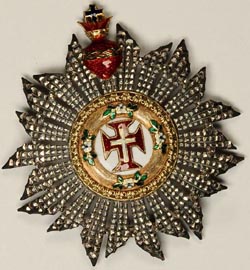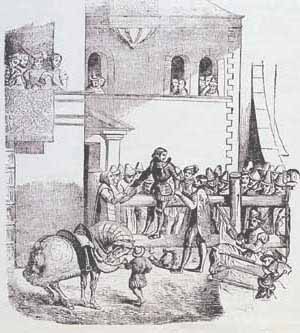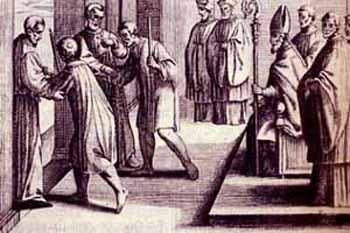 |
Church - State Relations
Public Awards and Punishments
Prof. Plinio Corrêa de Oliveira
We were recently asked to comment on the fact that the custom of conferring awards on the best students is being abolished in various schools. At the root of this new policy is the idea that the custom of giving public awards is doubly harmful: It raises vanity in those who are the beneficiaries of the honors, and it develops a guilt or inferiority complex in the others.
Since this topic plays a vital role in maintaining sanity in society, involves an appreciation for time-honored customs and is essential for the life of a civilization, we decided to deal with the topic. The question far transcends the school ambit and directly touches on the honors and punishment administered in all human societies.

Decoration bestowed by the Order of Christ |
According to the doctrine of St. Thomas, the fact that a person possesses authentic attributes and is recognized and honored for them by society is a good that is better than health or riches, inferior only to the grace of God, which transcends every other good (cf. II. II., q 129, a. 1, c; a.3, c).
Therefore, to deprive the best of the honor that is rightfully theirs is a flagrant injustice because it inflicts a loss, a very grave loss, upon those who merit the exact opposite.
Moreover, the awarding of honors does not make truly virtuous men proud, but stimulates them to advance further in virtue. As for the others, it does not degrade them; rather, it invites them to a laudable imitation.
This was taught by St. Pius X in the Brief, Multum ad excitandos of February 7, 1905, with regard to the Supreme Order of the Army of Our Lord Jesus Christ, usually called the Order of Christ. It is the highest honorific Order of the Holy See, and, therefore, of all Christianity.
He said: “Rewards granted for merit play a powerful role in stimulating hearts with the desire to carry out generous acts, for if men of the Church or society who singularly deserved it are vested with glory, they provide a stimulus for everyone else to follow the same path of glory and honor. According to this wise principle, the Roman Pontiffs, our Predecessors, considered the knightly Orders with special favor as another such stimulus for the good. By their initiative, many Orders were created, and others, which had been previously instituted, were restored to their original dignity and endowed with new and greater privileges.”
In this spirit, the Holy Church established various honors to stimulate the laymen. She also provided various honorific titles to reward her priests: The titles of Monsignor and honorary Canon are characteristic examples.
Also in this sense, the Church established ceremonies for inflicting a note of infamy upon those who deserve it. We need only mention the terrible ritual for the demotion of priests, or, in the Middle Ages, the analogous ceremony for knights deemed unworthy of the name.

A knight degraded at a public ceremony |
The picture above shows the medal denoting singular rank in the Order of Christ. Everything about it – its form, its color, the fact that it should be worn openly on the chest – indicates the Church’s intent that it be visible to all. Thus she proclaims with great pomp the merits of its bearer.
The next picture, at left, represents a wood engraving dated 1565, showing a knight who is being publicly degraded. Knighthood was a sacramental. Therefore, the demotion of a knight was carried out not only with the cooperation of the Church, but with her full approval.
In the picture, the knight, who dishonored his rank by some infamous crime, is mounted with derision on something like a pole horse, which is a wooden fence beam. At the side we see a page holding his charger, which he has been forced to dismount.
The ceremony is half over. They have already divested him of his helmet and gloves, which were cast to the ground. Two knights in ceremonial attire are now removing his arm shields. Thus, piece by piece, he will be divested of all his armor. Gathered in the public square or assisting at upper story windows, the public watches, horrified and edified by the ceremony.
A contemporary application
Reminiscences from days of yore, one might say. No. That ceremony, unfortunately laicized, still exists in all modern armies under the form of military demotion. And even today, the Holy Church punishes infamy to the great benefit of the defense of public morality, just as it also constantly and maternally confers honors upon deserving laymen and ecclesiastics. The awarding of honors is so well-known and frequent that examples are superfluous.

Ceremony of expulsion of public sinners from the Church |
As for the application of punishment, we offer an example provided by the expressive decree of the Cardinal Archbishop of Bogota, Colombia, published in the April 24, 1958 edition of El Catolicismo. The essential paragraphs are the following:
“We, Cristanto Luque, Cardinal Presbiter of the Holy Roman Church, invoking Sts. Cosmos and Damian, by the grace of God and the Holy See Apostolic, Archbishop of Bogota and Primate of Colombia, considering that:
“1. Canon 2356 of the Code of Canon Law disposes that bigamists are ipso facto infamous and that, if they disregard the admonitions of the Ordinary and remain in their illicit relationship, they should be excommunicated or punished with a personal interdict, depending upon the gravity of their fault. …
“4. By public documents, it was demonstrated that Dr. Hernando Diaz Rubio and Mrs. Olda Pardo contracted a so-called civil marriage in Ibarra, Ecuador, Dr. Diaz Rubio being bound by a previous marriage yet having intimate liaison with Mrs. Pardo;
"We thus declare:
“1. By the very fact of having ventured to contract this so-called civil marriage, they are infamous and are subject to all the canonical consequences of infamy by law … (Canons 2356 and 2294, § 1°, Code of Canon Law); …
“3. The guilty parties should be notified of this decree and thus be reminded of their duty to separate under the threat of excommunication should they remain in their illicit liaison, and this is to be published in the public press so that it might produce the desired social effects.”
In short, to confer public awards and impose defaming public punishments conforms to the Morals and practices of the Holy Church. In our opinion, any school of thought that denies this cannot be considered effective, nor well oriented.

First published in Catolicismo, January 1959
Translated by TIA desk
Posted July 28, 2010

Related Topics of Interest
 Laws that Generate True Peace Laws that Generate True Peace
 Authentic and Artificial Leadership Authentic and Artificial Leadership
 The Debasement of Knighthood The Debasement of Knighthood
 Discipline for Young Children Discipline for Young Children
 What Is the Punishment for an Unwed Father? What Is the Punishment for an Unwed Father?
 Unwed Mothers: The Calvinist and the Catholic Answers Unwed Mothers: The Calvinist and the Catholic Answers
 Convent Prisons - How Did They Work? Convent Prisons - How Did They Work?

Related Works of Interest
|
|
Church-State | Cultural | Home | Books | CDs | Search | Contact Us | Donate

© 2002- Tradition in Action, Inc. All Rights Reserved
|
 |

|